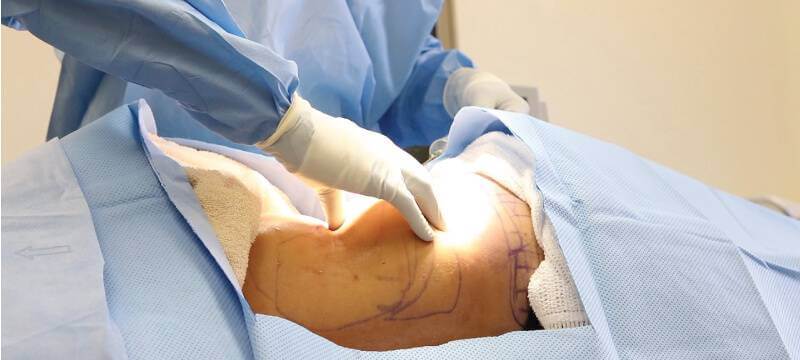Skin Necrosis & Plastic Surgery: What You Should Know

Skin necrosis is a rare side effect of any surgical procedure, including cosmetic surgery. Skin necrosis occurs when the blood supply to the skin is interrupted or damaged. This limits the delivery of oxygen and nutrients and results in the death of skin tissue.
In this blog post we’ll discuss skin necrosis including symptoms, risk of occurrence, preventive measures, and treatment options.
How Does Skin Necrosis Occur?
Your skin is kept healthy and alive via a network of small capillaries which deliver oxygen and other nutrients to the skin’s surface.
Any type of trauma, including that which occurs during surgery, can disrupt this network of small blood vessels, resulting in ischemia, decreased blood supply, or hypoxia, lack of oxygen.
Trauma may include the severing of blood vessels, tightening of the skin via sutures, or pressure from post-surgery blood clots. Sometimes, skin necrosis is the result of bacterial or fungal infections. It can also occur if dermal filler is mistakenly injected into a blood vessel, blocking the flow of blood.
Can Plastic Surgery Cause Skin Necrosis?
Any and all types of surgery injure blood vessels. Once a surgeon cuts into your skin, some blood vessel damage will occur. Typically, the body is quick to adjust and the blood supply is rerouted.
Excessive injury to an area or risk factors such as smoking, diabetes or obesity, however, make it difficult for the body to heal. When an area is cut off from its blood supply, skin necrosis is the result.
How Common Is Skin Necrosis After Plastic Surgery?
Skin necrosis is a rare complication of cosmetic surgery. While studies have yet to be done to determine the exact rates of skin necrosis for each type of plastic surgery, the following are best estimates of the risk.
- Rhinoplasty has a very low risk of less than 1%
- After a facelift, risk of necrosis is approximately 2–3%
- Fat or nipple necrosis after breast reduction could be as high as 10%
- Risk of skin necrosis after a tummy tuck may be as high as 15%
Generally, the more complicated the surgery, the higher the risk of skin necrosis. Still, for each of the studies above, smoking was the most common risk factor among those who developed necrosis.
What Are the Signs of Skin Necrosis?
The symptoms of skin necrosis can appear as early as 2-4 days after surgery and may progress hourly. It’s important to closely monitor your healing, as early identification offers the best chance for recovery. Contact your doctor immediately if you notice any of the following:
- An increase in pain, swelling or redness
- A fever or warmth in the incision area
- An open wound that does not appear to be healing
- Dry, scaly or thick skin at the incision site
- Dark, blue or black discoloration at the incision site
If you’re unsure, err on the side of caution and report your symptoms. The earlier skin necrosis is diagnosed, the better your chances of healing.
Can Skin Necrosis Be Prevented?
With any surgery, skin necrosis is a risk. However, this minimal risk can be reduced even further by selecting a skilled plastic surgeon, and by refraining from smoking.
Non-Smoking: Smoking is the biggest risk factor for skin necrosis. Nicotine is a vasoconstrictor, meaning it shrinks your blood vessels. This impedes the flow of oxygen and nutrients to the skin. It also slows the healing process, which puts you at risk for infection.
If you smoke, quit at least 2-4 weeks before your surgery. Refrain from the use of all nicotine products until you are fully healed.
Choosing a Skilled Surgeon: A skilled, experienced, board-certified cosmetic surgeon will perform your surgery more efficiently, damaging fewer blood vessels in the process. This can reduce the risk of skin necrosis by minimizing trauma.
How Is Necrosis Treated in The Event of an Occurrence?
To be effective, treatment for necrosis must begin as early as possible. In some cases, necrosis of a small area may resolve on its own, but can still leave scarring that negatively affects cosmetic outcomes.
Depending on the cause, size, area and appearance of the skin necrosis, your doctor may treat it in any of the following ways
Wet to Dry Dressings: Using saline-treated dressings and changing them frequently can speed the process of wound healing, preventing the progress of skin necrosis.
Antibiotics: If a bacterial or fungal infection is the cause of the necrosis, it may be treated with the use of antibiotics or antifungal medications.
Negative Pressure Wound Therapy: NPWT helps wounds heal faster by drawing fluid from the area, stimulating the circulation of blood.
Hyperbaric Oxygen Therapy: HBOT exposes skin cells to oxygen, promoting healing in otherwise oxygen-deprived tissues.
Debridement: In severe cases, the affected tissue must be removed through surgical or other means. This triggers the healing process anew, but can leave permanent scarring or disfigurement.
Summary
While skin necrosis is a risk of any surgery, it’s relatively rare. Approaching your cosmetic surgery in general good health, at or near your ideal body weight, and as a non-smoker is the most important thing you can do to reduce your risk of skin necrosis.
